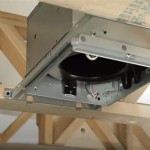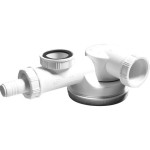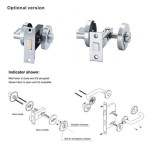DIY Bathroom Sink Storage Solutions: Maximizing Space and Enhancing Organization
Bathroom sink storage often presents a challenge, especially in smaller bathrooms. The area beneath the sink is frequently underutilized, leading to clutter and disorganization. However, with a bit of planning and DIY effort, it’s possible to transform this space into a functional and aesthetically pleasing storage solution. This article explores various DIY bathroom sink storage ideas, offering practical advice and step-by-step guidance to help optimize bathroom organization.
Understanding Your Needs and Space
Before embarking on any DIY project, it's crucial to assess the specific storage needs and accurately measure the available space under the sink. Consider the items that need to be stored, such as toiletries, cleaning supplies, towels, and hair styling tools. Categorize these items and estimate the required space for each category. This initial assessment will guide the design and construction of the storage solution.
Accurate measurements are equally important. Measure the width, height, and depth of the under-sink cabinet, taking into account any plumbing obstructions. Note the position of pipes and ensure that the chosen storage solution doesn't interfere with them. In some cases, it may be necessary to cut or modify shelves or drawers to accommodate plumbing fixtures.
Consider the overall style of the bathroom when selecting materials and finishes. Aim for a design that complements the existing decor and enhances the aesthetic appeal of the space. Choose materials that are durable, water-resistant, and easy to clean, as the under-sink area is prone to moisture exposure.
DIY Storage Ideas: From Simple to Advanced
There are numerous DIY storage solutions for under the bathroom sink, ranging from simple projects that require minimal tools and skills to more complex constructions that involve carpentry and plumbing modifications. The choice depends on individual skill levels, budget constraints, and desired level of customization.
Simple Solutions:
One of the simplest and most cost-effective solutions is using adjustable shelves. These shelves can be purchased at most home improvement stores and can be easily adjusted to fit the available space and accommodate various items. Adjustable shelves are particularly useful for storing taller items, such as hairspray cans or cleaning bottles.
Another easy option is utilizing storage baskets. These baskets can be made from various materials, such as plastic, wicker, or metal, and can be used to organize smaller items, such as cotton balls, Q-tips, and makeup. Choose baskets that are the appropriate size for the available space and that complement the overall style of the bathroom.
Over-the-cabinet-door organizers are another practical solution for maximizing storage space. These organizers typically consist of a series of hooks or pockets that can be used to store items such as hair styling tools, cleaning supplies, or small toiletries. Ensure that the organizer is securely attached to the cabinet door and doesn't interfere with its closing.
Intermediate Solutions:
A slightly more advanced DIY project involves building custom shelves. This allows for complete customization of the storage space, ensuring that it perfectly fits the available area and accommodates specific storage needs. Use plywood or MDF for the shelves and cut them to the desired size using a saw. Secure the shelves to the cabinet walls using wood screws or shelf supports.
Another option is to create pull-out drawers. This provides easy access to items stored at the back of the cabinet and helps prevent items from getting lost or forgotten. Build the drawers using plywood or MDF and attach them to drawer slides. Ensure that the drawer slides are appropriately sized for the drawers and that they are securely attached to the cabinet walls.
Consider adding a lazy Susan to spin items to the front of the cabinet. This is particularly helpful for organizing cleaning supplies or other small items that are frequently used. Lazy Susans are available in various sizes and materials and can be easily installed in the under-sink cabinet.
Advanced Solutions:
For those with advanced carpentry skills, it's possible to build a completely custom under-sink cabinet. This allows for complete customization of the design and materials, ensuring that the cabinet perfectly meets specific storage needs and complements the overall style of the bathroom. This project involves careful planning, precise measurements, and advanced carpentry techniques.
Another advanced solution involves modifying the plumbing to create more storage space. This may involve moving pipes or rerouting them to create more space for shelves or drawers. This project requires specialized plumbing skills and should only be undertaken by experienced individuals or professionals.
Materials and Tools Needed
The materials and tools needed for DIY bathroom sink storage projects will vary depending on the specific project being undertaken. However, some common materials and tools include:
Materials:
- Plywood or MDF: Used for building shelves, drawers, and cabinets.
- Wood screws: Used for securing shelves and drawers to the cabinet walls.
- Shelf supports: Used to support shelves.
- Drawer slides: Used for installing pull-out drawers.
- Paint or stain: Used to finish the wood and protect it from moisture.
- Storage baskets: Used for organizing smaller items.
- Over-the-cabinet-door organizers: Used for maximizing storage space on the cabinet door.
- Adjustable shelves: Used for creating flexible storage solutions.
Tools:
- Measuring tape: Used for accurate measurements.
- Saw: Used for cutting wood to the desired size.
- Drill: Used for drilling pilot holes and driving screws.
- Screwdriver: Used for tightening screws.
- Level: Used for ensuring that shelves and drawers are level.
- Sandpaper: Used for smoothing rough edges.
- Paintbrush or roller: Used for applying paint or stain.
Safety glasses and gloves are recommended when working with power tools and potentially hazardous materials.
Step-by-Step Guide to Building Simple Under-Sink Shelves
This section provides a step-by-step guide to building simple under-sink shelves. This project is relatively easy and requires minimal tools and skills.
Step 1: Measure the Under-Sink Cabinet
Accurately measure the width, height, and depth of the under-sink cabinet. Note the position of any plumbing obstructions. These measurements will determine the size and number of shelves that can be installed.
Step 2: Cut the Shelves
Using a saw, cut the plywood or MDF to the desired size for the shelves. Ensure that the shelves are slightly smaller than the interior dimensions of the cabinet to allow for easy installation and removal. It's advisable to create a template from cardboard first to ensure proper fit.
Step 3: Sand the Edges
Sand the edges of the shelves to smooth any rough spots and prevent splinters. Use fine-grit sandpaper for a smooth finish.
Step 4: Paint or Stain the Shelves
Paint or stain the shelves to protect them from moisture and to match the overall decor of the bathroom. Apply several coats of paint or stain, allowing each coat to dry completely before applying the next.
Step 5: Install Shelf Supports
Install shelf supports on the inside walls of the cabinet. Use a level to ensure that the supports are level and evenly spaced. Attach the supports to the walls using wood screws.
Step 6: Place the Shelves on the Supports
Carefully place the shelves on the shelf supports. Ensure that the shelves are securely supported and that they are level.
Maintaining and Optimizing Your DIY Storage
Once the DIY bathroom sink storage solution is complete, it's important to maintain it and optimize its functionality. Regularly clean the storage area to prevent the buildup of dirt, dust, and moisture. Use a damp cloth to wipe down surfaces and remove any spills or stains. Periodically inspect the shelves, drawers, and supports to ensure that they are in good condition and that they are securely attached.
Re-evaluate the storage needs periodically and make adjustments to the organization as needed. As storage needs change, consider adding or removing shelves, drawers, or baskets to optimize the use of space. Label storage containers to easily identify their contents. This simplifies locating items and maintaining an organized system.
Consider adding lighting to the under-sink cabinet to improve visibility. Install a small LED light strip inside the cabinet to illuminate the contents and make it easier to find items. Choose a light that is energy-efficient and easy to install.

10 Diy Bathroom Vanity Ideas The Family Handyman

How To Build A Bathroom Vanity Sliding Shelf Interior Frugalista
:max_bytes(150000):strip_icc()/build-something-diy-vanity-594402125f9b58d58ae21158.jpg?strip=all)
16 Diy Bathroom Vanity Plans You Can Build Today

Diy Bathroom Vanity 12 Rehabs Bob Vila

10 Diy Bathroom Vanity Ideas 2024 The Storage Plus Unique Small Vanities

Diy Bathroom Vanity Ideas Perfect For Repurposers

Rustic Bathroom Vanity Kreg Tool

Diy Bathroom Vanity Ideas

Under Sink Storage Solutions That Will Get And Keep You Organized Small Bathroom Diy Pedestal

Under Bathroom Sink Organization Ideas For Small Powder Room Cabinets Blue I Style
Related Posts







